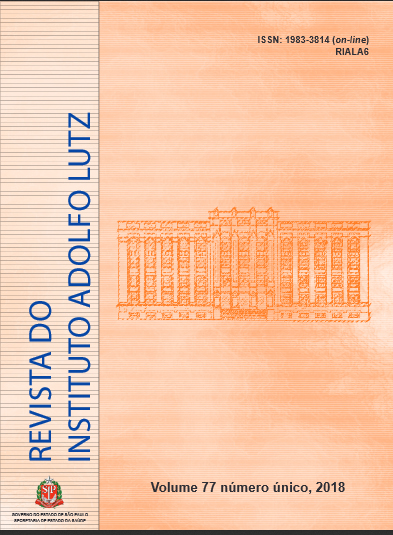Resumo
Em laboratório de biologia molecular existem normas para prevenir que nucleases destruam os ácidos nucleicos em análise. Rígida adesão a estas normas é primordial, principalmente em laboratórios de análises clínicas e ao se lidar com amostras com número restrito de cópias do genoma-alvo. Em contraposição, diversas nucleases têm tido importância fundamental, por exemplo, na identificação do ácido nucleico de vírus, investigação de RNA mensageiro, purificação de vírus em abordagem metagenômica, edição de genomas com o sistema CRISPR/Cas e descoberta de enzimas. O conhecimento de como nucleases podem ser tanto vilãs quanto aliadas é essencial na formação de todos que trabalham no campo de biologia molecular.
Referências
1. Mishra NC. Nucleases: Molecular biology and applications. Hoboken (NJ): Wiley-Interscience;2002.
2. Farrell Jr. RE. RNA methodologies. A laboratory guide for isolation and characterization. 4.ed. Boston (MA): Academic Press;2010.
3. Miller JM, Astles R, Baszler T, Chapin K, Carey R, Garcia L et al. Guidelines for safe work practices in human and animal medical diagnostic laboratories. Recommendations of a CDC-convened, Biosafety Blue Ribbon Panel. MMWR Suppl. 2012;61(1):1-102. Disponível em: https://www.cdc.gov/mmwr/pdf/other/su6101.pdf
4. Sambrook J, Russell DW, editors. Molecular cloning: a laboratory manual. 3.ed. Cold Spring Harbor (NY): Cold Spring Harbor Laboratory Press;2001.
5. Whelan S. Viral replication strategies. In: Knipe DM, Howley, PM, editors. Fields virology. 6.ed. Philadelphia (PA): Lippincott Williams and Wilkins; 2013. pp. 105-26.
6. Pereira HG, Flewett TH, Candeias JAN, Barth OM. A virus with a bisegmented double-stranded RNA genome in rat (Oryzomys nigripes) intestines. J Gen Virol. 1988; 69(Pt 11):2749-54. http://dx.doi.org/10.1099/0022-1317-69-11-2749
7. Rittié L, Perbal B. Enzymes used in molecular biology: a useful guide. J Cell Commun Signal. 2008;2(1-2):25-45. http://dx.doi.org/10.1007/s12079-008-0026-2
8. Ludert JE, Hidalgo M, Gil F, Liprandi F. Identification in porcine faeces of a novel virus with a bisegmented double stranded RNA genome. Arch Virol. 1991;117(1-2):97-107.
9. Ehresmann C, Baudin F, Mougel M, Romby P, Ebel J-P, Ehresmann B. Probing the structure of RNAs in solution. Nucleic Acids Res. 1987;15(22):9109-28. Disponível em: https://www.ncbi.nlm.nih.gov/pmc/articles/PMC306456/
10. Tomaru Y, Takao Y, Suzuki H, Nagumo T, Koike K, Nagasaki K. Isolation and characterization of a single-stranded DNA virus infecting Chaetoceros lorenzianus Grunow. Appl Environ Microbiol. 2011;77(15):5285-93. http://dx.doi.org/10.1128/AEM.00202-11
11. Alexander M, Heppel LA, Hurwitz J. The purification and properties of micrococcal nuclease. J Biol Chem. 1961;236(11):3014-9. Disponível em: http://www.jbc.org/content/236/11/3014.long
12. Baltimore D. RNA-dependent DNA polymerase in virions of RNA tumour viruses. Nature. 1970;226(5252):1209-11.
13. Temin HM, Mizutani S. RNA-dependent DNA polymerase in virions of Rous sarcoma virus. Nature. 1970;226(5252):1211-3.
14. Knipe DM, Howley PM, editors. Fields virology. 6.ed. Philadelphia (PA): Lippincott Williams and Wilkins;2013.
15. Weinberger B, Plentz A, Weinberger KM, Hahn J, Holler E, Jilg W. Quantitation of Epstein-Barr virus mRNA using reverse transcription and real-time PCR. J Med Virol. 2004;74(4):612-8. https://doi.org/10.1002/jmv.20220
16. Iwata S, Wada K, Tobita S, Gotoh K, Ito Y, Demachi-Okamura A et al. Quantitative analysis of Epstein-Barr virus (EBV)-related gene expression in patients with chronic active EBV infection. J Gen Virol. 2010;91(Pt 1): 42-50. http://dx.doi.org/10.1099/vir.0.013482-0
17. Bressollette-Bodin C, Nguyen TV, Illiaquer M, Besse B, Peltier C, Chevallier P et al. Quantification of two viral transcripts by real time PCR to investigate human herpesvirus type 6 active infection. J Clin Virol. 2014; 59(2):94-9. http://dx.doi.org/10.1016/j.jcv.2013.11.014
18. Greijer AE, Ramayanti O, Verkuijlen SA, Novalić Z, Juwana H, Middeldorp JM. Quantitative multi-target RNA profiling in Epstein-Barr virus infected tumor cells. J Virol Methods. 2017;241:24-33. http://dx.doi.org/10.1016/j.jviromet.2016.12.007
19. Garlapati S, Wang CC. Identification of an essential pseudoknot in the putative downstream internal ribosome entry site in giardiavirus transcript. RNA. 2002;8(5):601-11. Disponível em: https://www.ncbi.nlm.nih.gov/pmc/articles/PMC1370281/
20. Garlapati S, Wang CC. Structural elements in the 5’-untranslated region of giardiavirus transcript essential for internal ribosome entry site-mediated translation initiation. Eukaryot Cell. 2005;4(4):742-54. http://dx.doi.org/10.1128/EC.4.4.742-754.2005
21. Ambrose HE, Clewley JP. Virus discovery by sequence-independent genome amplification. Rev Med Virol. 2006;16(6):365-83. http://dx.doi.org/10.1002/rmv.515
22. Delwart EL. Viral Metagenomics. Rev Med Virol. 2007;17(2):115-31. http://dx.doi.org/10.1002/rmv.532
23. Allander T, Emerson SU, Engle RE, Purcell RH, Bukh J. A virus discovery method incorporating DNase treatment and its application to the identification of two bovine parvovirus species. Proc Natl Acad Sci USA. 2001;98(20):11609-14. http://dx.doi.org/10.1073/pnas.211424698
24. Djikeng A, Kuzmickas R, Anderson NG, Spiro DJ. Metagenomic analysis of RNA viruses in a fresh water lake. PLoS One. 2009;4(9):e7264. http://dx.doi.org/0.1371/journal.pone.0007264
25. Conklin BR. Sculpting genomes with a hammer and chisel. Nat Methods. 2013;10(9):839-40. http://dx.doi.org/10.1038/nmeth.2608
26. Gaj T, Gersbach CA, Barbas CF III. ZFN, TALEN, and CRISPR/Cas-based methods for genome engineering. Trends Biotechnol. 2013;31(7):397-405. http://dx.doi.org/ 10.1016/j.tibtech.2013.04.004
27. Soppe JA, Lebbink RJ. Antiviral goes viral: harnessing CRISPR/Cas9 to combat viruses in humans. Trends Microbiol. 2017;25(10):833-50. http://dx.doi.org/10.1016/j.tim.2017.04.005
28. Saey TH. Gene drivers spread their wings. Science News. 2015;188(12):16. Disponível em: https://www.sciencenews.org/article/gene-drives-spread-their-wings
29. Chen S, Yu X, Guo D. CRISPR-Cas targeting of host genes as an antiviral strategy. Viruses. 2018;10(1):e40. http://dx.doi.org/10.3390/v10010040

Este trabalho está licenciado sob uma licença Creative Commons Attribution 4.0 International License.
Copyright (c) 2018 Silvana Beres Castrignano
